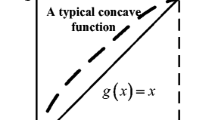Abstract
The cumulative prospect theory (CPT) is applied to study travelers’ route choice behavior in a degradable transport network. A cumulative prospect theory-based user equilibrium (CPT-UE) model considering stochastic perception error (SPE) within travelers’ route choice decision process is developed. The SPE is conditionally dependent on the actual travel time distribution, which is different from the deterministic perception error used in the traditional logit-based stochastic user equilibrium. The CPT-UE model is formulated as a variational inequality problem and solved by a heuristic solution algorithm. Numerical examples are provided to illustrate the application of the proposed model and efficiency of the solution algorithm. The effects of SPE on the reference point determination, cumulative prospect value estimation, route choice decision and network performance evaluation are investigated.
Similar content being viewed by others
References
AVINERI E. The effect of reference point on stochastic network equilibrium [J]. Transportation Science, 2006, 40(4): 409–420.
CONNORS R D, SUMALEE A. A network equilibrium model with travelers’ perception of stochastic travel times [J]. Transportation Research Part B, 2009, 43(6): 614–624.
SUMALEE A, CONNORS R D, LUATHEP P. Network equilibrium under cumulative prospect theory and endogenous stochastic demand and supply [C]// Proceeding of the 18th International Symposium Transportation and Traffic Theory. New York: Springer, 2009: 19–38.
XU H, LOU Y, YIN Y, ZHOU J. A prospect-based user equilibrium model with endogenous reference points and its application in congestion pricing [J]. Transportation Research Part B, 2011, 45(2): 311–328.
TIAN L J, HUANG H J, GAO Z Y. A cumulative perceived value-based dynamic user equilibrium model considering the travelers’ risk evaluation on arrival time [J]. Network and Spatial Economics, 2012, 12(4): 589–608.
YANG J F, JIANG G Y. Development of an enhanced route choice based on cumulative prospect theory [J]. Transportation Research Part C, 2014, 47(2): 168–178.
XU H L, LAM W H K, ZHOU J. Modeling road users’ behavioral change over time in stochastic road networks with guidance information [J]. Transportmetrica B: Transport Dynamics, 2014, 2(1): 20–39.
MIRCHANDANI P, SOROUSH H. Generalized traffic equilibrium with probabilistic travel times and perceptions [J]. Transportation Science, 1987, 21(3): 133–152.
CHEN A, ZHOU Z, LAM W H K. Modeling stochastic perception error in the mean-excess traffic equilibrium model [J]. Transportation Research Part B, 2011, 45(10): 1619–1640.
XU X D, CHEN A, CHENG L. Assessing the effects of stochastic perception error under travel time variability [J]. Transportation, 2013, 40(3): 525–548.
LO H K, LUO X W, SIU B W Y. Degradable transport network: travel time budget of travelers with heterogeneous risk aversion [J]. Transportation Research Part B, 2006, 40(9): 792–806.
SIU B W Y, LO H K. Travel time budget in doubly uncertain transport network: Degradable capacity and stochastic demand [J]. European Journal of Operational Research, 2008, 191(1): 166–181.
HILL I D, HILL R, HOLDER R L. Algorithm AS 99: Fitting Johnson curves by moments [J]. Journal of the Royal Statistical Society: Series C (Applied Statistics), 1976, 25(2): 180–189.
CLARK S, WALTING D. Modeling network travel time reliability under stochastic demand [J]. Transportation Research Part B, 2005, 39(2): 119–140.
WANG W, SUN H J, WU J J. Robust user equilibrium model based on cumulative prospect theory under distribution-free travel time [J]. Journal of Central South University, 2015, 22(2): 761–770.
Author information
Authors and Affiliations
Corresponding author
Additional information
Foundation item: Project(2012CB725400) supported by the National Basic Research Program of China; Projects(71271023, 71322102) supported by the National Science Foundation of China; Project(2015JBM053) supported by the Fundamental Research Funds for the Central Universities, China
Rights and permissions
About this article
Cite this article
Wang, W., Sun, Hj. Cumulative prospect theory-based user equilibrium model with stochastic perception errors. J. Cent. South Univ. 23, 2465–2474 (2016). https://doi.org/10.1007/s11771-016-3305-8
Received:
Accepted:
Published:
Issue Date:
DOI: https://doi.org/10.1007/s11771-016-3305-8



